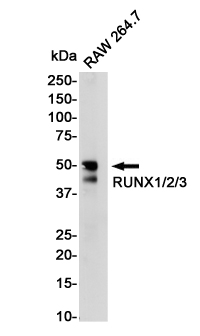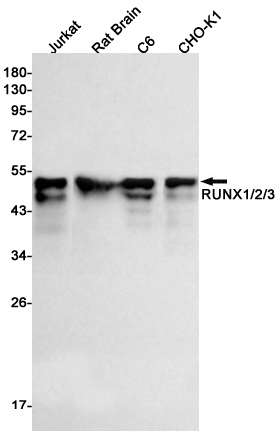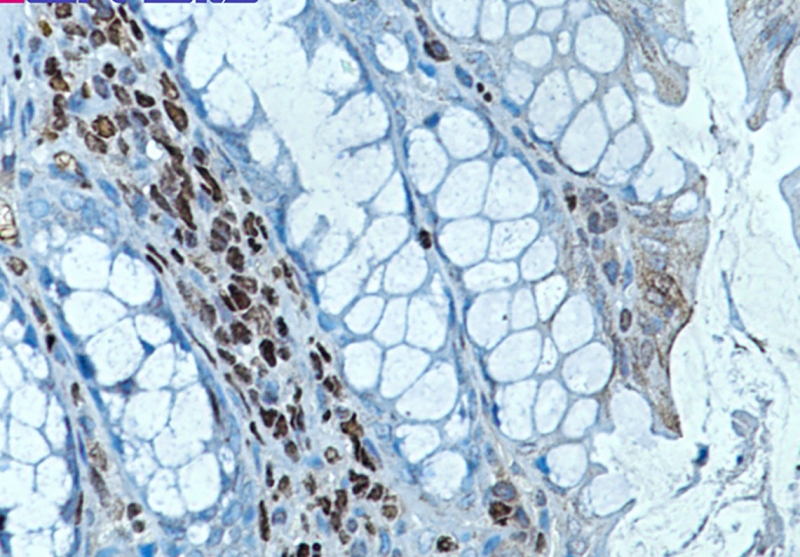



| WB | 1/500-1/1000 | Human,Mouse,Rat |
| IF | 1/20 | Human,Mouse,Rat |
| IHC | 1/50-1/100 | Human,Mouse,Rat |
| ICC | 1/50-1/200 | Human,Mouse,Rat |
| FCM | 咨询技术 | Human,Mouse,Rat |
| Elisa | 咨询技术 | Human,Mouse,Rat |
| Aliases | RUNX1; AML1; RUNX2; OSF2; RUNX3; CBFA3 |
| Entrez GeneID | 861/864/860 |
| WB Predicted band size | Calculated MW: 49 kDa; Observed MW: 49 kDa |
| Host/Isotype | Rabbit IgG |
| Antibody Type | Primary antibody |
| Storage | Store at 4°C short term. Aliquot and store at -20°C long term. Avoid freeze/thaw cycles. |
| Species Reactivity | Human,Mouse,Rat |
| Immunogen | A synthetic peptide of human RUNX1/2/3 |
| Formulation | Purified antibody in TBS with 0.05% sodium azide,0.05%BSA and 50% glycerol. |
+ +
以下是3篇与RUNX抗体相关的参考文献及其摘要概括:
---
1. **"RUNX proteins in development and cancer"**
*作者:Nancy A. Speck 等*
**摘要**:综述RUNX家族(RUNX1/2/3)在胚胎发育、细胞分化和肿瘤发生中的作用,重点讨论了针对RUNX蛋白特异性抗体的应用,包括染色质免疫沉淀(ChIP)和免疫组织化学分析其在白血病和实体瘤中的异常表达。
2. **"Regulation of osteoblast differentiation by Runx2"**
*作者:Takeshi Imamura 等*
**摘要**:研究RUNX2调控成骨分化的分子机制,通过Western blot和免疫荧光技术使用抗RUNX2抗体,证实其在骨形成中的核心作用及与骨骼疾病的关联。
3. **"RUNX3 suppresses gastric cancer metastasis through inactivation of MMP9 by antibody-based targeting"**
*作者:Yoshiaki Ito 等*
**摘要**:揭示RUNX3通过抑制MMP9表达抑制胃癌转移,利用特异性RUNX3抗体进行免疫共沉淀和组织芯片分析,证明其作为抑癌基因的临床意义。
---
以上文献均涉及RUNX抗体的实验应用(如蛋白检测、功能研究),涵盖癌症、骨发育和疾病机制领域。
RUNX antibodies are essential tools in studying the RUNX family of transcription factors, which includes three members: RUNX1. RUNX2. and RUNX3. These evolutionarily conserved proteins play pivotal roles in development, differentiation, and oncogenesis by regulating gene expression through binding to specific DNA motifs. RUNX1 (AML1) is crucial for hematopoiesis and is frequently involved in chromosomal translocations in leukemia. RUNX2 governs osteoblast differentiation and bone formation, while RUNX3 functions as a tumor suppressor in epithelial cancers and participates in immune regulation.
Researchers utilize RUNX antibodies to detect protein expression, localization, and functional interactions in various experimental contexts. These antibodies enable techniques such as Western blotting, immunohistochemistry (IHC), immunofluorescence (IF), and chromatin immunoprecipitation (ChIP). Their applications span cancer research (e.g., studying RUNX1-ETO fusion in AML), skeletal biology (RUNX2 in bone disorders), and gastrointestinal malignancies (RUNX3 silencing mechanisms). However, challenges persist in ensuring antibody specificity due to high homology among RUNX family members and the existence of multiple isoforms. Validation using knockout controls or siRNA-mediated knockdown is critical for reliable results. Recent advancements in recombinant antibody technology have improved detection accuracy, particularly for distinguishing post-translational modifications that regulate RUNX protein activity. These reagents remain indispensable for unraveling the complex roles of RUNX factors in health and disease.
×